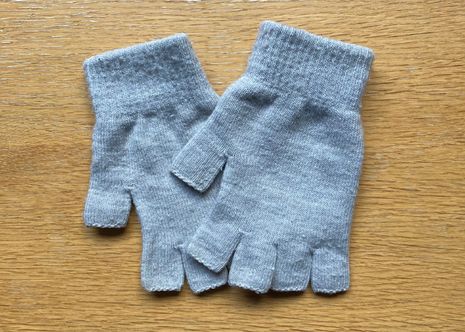‘Knick-knacks’: Fingerless gloves
In the second installation of her column, Eve Connor discusses intimacy, communication and sensation, all through a pair of knitted fingerless gloves

An Appletiser deep into a night at Sidney Bar, a friend was kind enough to ask what I would write about next for this column. I explained the process was organic, that I couldn’t predict an object until I discovered it. “Just need something remarkable to happen in the next two weeks,” I joked.
The walk back to college coincided with that time – maybe 20 or 30 minutes to midnight – when the shops close their doors but keep on their lights, a dozen Edward Hopper paintings illumined along King’s Parade: a barista glanced inside a café window untying their apron or the slow undulations of a mechanical polar bear in a gift shop display, waving to the emptied street. We attended these scenes like visitors in a gallery, appearing for a moment under a streetlamp before peeling into the background, and it was perhaps this artistic feeling that attracted us to the Corpus Clock.
“As a wise friend once observed: ‘It’s giving Bill Sikes’”
I have an affection for the clock. I know a few people who could do with a reminder of their mortality on the hour. Devoid of the tourist crowds, its hollow clank echoed through the night. A great mist had descended. I realised all at once that this was remarkable – and that my fingers were freezing.
In his 1609 double portrait The Honeysuckle Bower, Peter Paul Rubens relaxes under a gyre of blooms with his newlywed, Isabella Brant. Both figures are distinct: Rubens in his orange tights, soft moustache, and lace collar; Brant with her magnificent ruff, brocade bodice, and large Florentine hat. He looks out at us with gentle thoughtfulness. She, more focused, smiles like somebody worth talking to. Their right hands form the lone point of connection in the picture, his finger on the belly of her wrist.
Hands turn up everywhere. The prehistoric Cueva de las Manos (“Cave of the Hands”) or at the close of Milton’s Paradise Lost as Adam and Eve “hand in hand with wandring steps and slow, / Through Eden took thir solitarie way.” Orpheus leads Eurydice by the hand out of the Underworld, Tyr resigns his into the mouth of the wolf Fenrir, Robert Mitchum’s tattooed knuckles in The Night of the Hunter (1955) read “LOVE” and “HATE”, and, much later, my fingers were slowly reddening in the light of the Corpus Clock.
“It was enough to know they were there, something remarkable”
Just under the cuticles, they disappeared into grey knitted gloves. Now it is properly cold, these fingerless gloves no longer cut it. At most they are a token effort (I have designs on a college scarf as well as a new coat of the Peter Freuchen for Irving Penn variety). Nor can the gloves exactly be called fashionable unless they have gone so far the other way that style rises out of their contrariness or Jack-the-Ripper-esque accessories re-enter the mainstream. As a wise friend once observed: “It’s giving Bill Sikes.”
Nevertheless, the gloves are rarely not on me. They offer a sort of half-engagement with the world. I can still use my phone, I could feasibly pet Odysseus, the ginger University Library cat, if ever he revealed himself to me, while staying warmish. Like one of the scattered cinema-goers in Hopper’s New York Movie (1939), I might sit in the composition or turn my head and catch the pensive usherette, clearly the star of the piece, as easily as I could squeeze out of the aisle and the painting and go on with my life.
A similar artist is the Irish painter Gerard Dillon. He is looser, more surreal, and has none of the Americana of Hopper, yet the same sense of intimate isolation, a quiet and sometimes melancholy feeling, pervades his work. Take Dillon’s The Dreamer and the fingers, larger than life, folded over the side of the table. The Moon over the Bog is Rubens and Brant viewed at another angle, another time. Once you start looking, you can’t ignore the hands, gripping a plate and an armchair, raised over a mouth, tugging the corner of a shawl. In one painting, a man’s face is cropped out of frame in favour of his hands holding two hens by the wings. Among Dillon’s most charged compositions, Cottage Gable stands apart for including only a single hand, placed with forced casualness on the hip of one of two young men, stripped to their trunks and eyeing each other at a distance. Behind, a pair of skirted figures raise their handkerchiefs at an orange sailboat. More hands.
In front of the Corpus Clock, I felt in my pocket for my gloves. They were bundled together like a small, soft animal. I did not put them on. It was enough to know they were there, something remarkable.
 News / Eight Cambridge researchers awarded €17m in ERC research grants27 December 2025
News / Eight Cambridge researchers awarded €17m in ERC research grants27 December 2025 News / Downing investigates ‘mysterious’ underground burial vault 29 December 2025
News / Downing investigates ‘mysterious’ underground burial vault 29 December 2025 Lifestyle / Ask Auntie Alice29 December 2025
Lifestyle / Ask Auntie Alice29 December 2025 Sport / Hard work, heartbreak and hope: international gymnast Maddie Marshall’s journey 29 December 2025
Sport / Hard work, heartbreak and hope: international gymnast Maddie Marshall’s journey 29 December 2025 News / News in Brief: carols, card games, and canine calamities28 December 2025
News / News in Brief: carols, card games, and canine calamities28 December 2025







